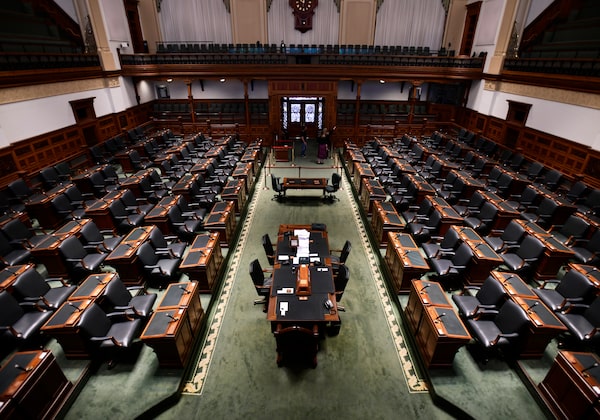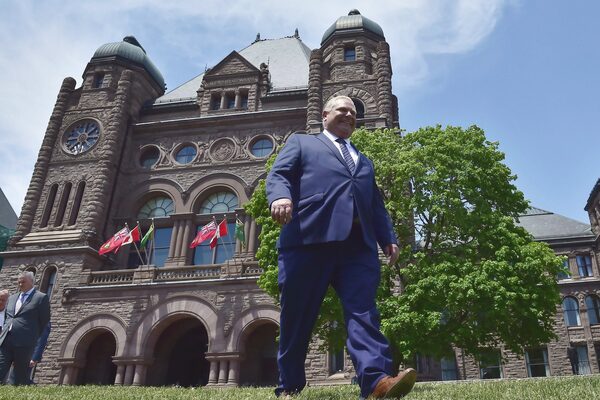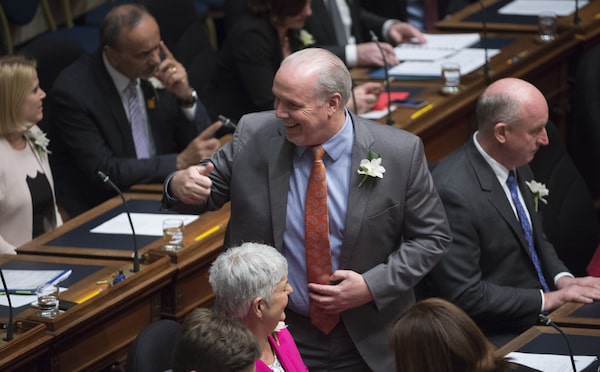
The Ontario legislature lies empty on July 3, and won't be back in session until Oct. 28. In a Globe and Mail analysis, Ontario was one of the few provinces to have more sitting days in the past decade than in the previous decade.Fred Lum/The Globe and Mail
A majority of provincial and territorial legislatures have sat for fewer days this decade compared with previous years, a Globe and Mail analysis has found.
According to data that goes back to 1987, nine of the 13 legislatures across Canada met less frequently on average over the past decade than they did in previous years, a trend one political scientist attributes to governments trying to avoid the scrutiny of Question Period.
Paul Thomas, a senior researcher with the Samara Centre for Democracy, blames it on the phenomenon of the “permanent campaign,” as political leaders attempt to control the news cycle by appearing at events much friendlier than Question Period, flanked by supporters and speaking behind podiums festooned with slogans. “The daily activities of the legislature give the opposition the chance to raise questions and to some extent set the agenda or at least attract attention," Dr. Thomas said. “Instead, the government would much rather be setting the topic and venue of discussion.”
British Columbia is the most egregious offender, having met an average of 10.4 fewer days this decade than in the past, going from an average of 66.3 days to 55.9.
Nunavut has met an average of 34.4 days each year this decade – 3.3 fewer – the lowest number of sittings for any legislature in the country.
Ontario’s is one of the four legislatures – together with Quebec’s, Prince Edward Island’s and the Northwest Territories’ – that bucks the trend. Ontario MPPs have seen their sitting days rise slightly, from an average of 84.7 a year between 1987 and 2009 to 85.67 since 2010. Ontario Premier Doug Ford has faced criticism for shutting down Queen’s Park for a five-month break, the legislature’s longest hiatus in a quarter-century. However, the government is on track to remain above the national average for sitting days.
Whether it’s a lengthy holiday or a legislature that meets for only a few weeks every year, it’s bad for democracy, says Dr. Thomas, who is also an adjunct professor at Carleton University.
“It’s not just the number of days that you are sitting, but also the break and the frequency. When the legislature isn’t sitting, that means you don’t have Question Period,” he said. “It deprives the opposition of the opportunity to hold ministers to account.”
However, he notes that Britain’s Parliament makes a point of meeting frequently throughout the year to ensure the government faces opposition questions. While Westminster typically meets as many as 150 days a year, it is currently embroiled in a marathon session that began in 2017 and has seen it sit for more than 300 days as it wrestles with leaving the European Union.
In Ottawa, the House of Commons sat for 122 days last year.

Doug Ford, then Ontario's premier-designate, walks outside the legislature on June 8, 2018.Frank Gunn/The Canadian Press
The 144-day break that Mr. Ford announced in June is the longest for the Ontario Legislature since then-premier Bob Rae shut it in December, 1994, with MPPs only returning after the June, 1995, election that saw him booted from power.
MPPs will not head back to their seats until Oct. 28, after the fall federal election.
Some critics have slagged it as a holiday, even though cabinet will continue to meet and the other business of government will go on.
NDP Opposition Leader Andrea Horwath suggested the move was either meant to allow Mr. Ford to campaign for Mr. Scheer (something the Premier has said he will not do) or allow him to lie low during the federal campaign, as polls show Mr. Ford’s popularity sagging.
The government argues it is anything but lazy. In 2019, MPPs have already met for 52 days. And if Mr. Ford calls them back on Oct. 28, they have enough time in their calendar to potentially meet for a total of 75 days in 2019 – well above the national average of 59.
The break also comes after MPPs spent 106 days at their desks in the legislature in 2018, passing what the government – which routinely used procedural rules to curtail debate – boasts is a record number of bills.

Sitting days for provincial and territorial
legislatures, including averages
Alberta
125
Current
decade
100
Past years
75
SITTING
DAYS
Avg.
50
25
0
1990
2000
2010
Manitoba
British Columbia
NFLD. and Labrador
New Brunswick
Nova Scotia
Northwest Territories
No data
Ontario
Nunavut
No data
Quebec
Prince Edward Island
Yukon
Saskatchewan
1990
2000
2010
1990
2000
2010
THE GLOBE AND MAIL, SOURCE:
PARLIAMENT OF CANADA, INDIVIDUAL LEGISLATURES

Sitting days for provincial and territorial
legislatures, including averages
Alberta
125
Current
decade
100
Past years
75
SITTING
DAYS
Avg.
50
25
0
1990
2000
2010
Manitoba
British Columbia
NFLD. and Labrador
New Brunswick
Nova Scotia
Northwest Territories
No data
Ontario
Nunavut
No data
Quebec
Prince Edward Island
Yukon
Saskatchewan
1990
2000
2010
1990
2000
2010
THE GLOBE AND MAIL, SOURCE:
PARLIAMENT OF CANADA, INDIVIDUAL LEGISLATURES

Sitting days for provincial and territorial
legislatures, including averages
Alberta
125
Current
decade
100
Past years
75
SITTING
DAYS
Avg.
50
25
0
1990
2000
2010
Manitoba
New Brunswick
British Columbia
Northwest Territories
Nova Scotia
NFLD. and Labrador
No data
Prince Edward Island
Ontario
Nunavut
No data
Yukon
Saskatchewan
Quebec
1990
2000
2010
1990
2000
2010
1990
2000
2010
THE GLOBE AND MAIL, SOURCE: PARLIAMENT OF CANADA, INDIVIDUAL LEGISLATURES

Sitting days for provincial and territorial
legislatures, including averages
Alberta
125
100
Current
decade
Past years
75
SITTING
DAYS
Avg.
50
25
0
1990
2000
2010
Manitoba
New Brunswick
British Columbia
Northwest Territories
Nova Scotia
NFLD. and Labrador
No data
Prince Edward Island
Ontario
Nunavut
No data
Yukon
Saskatchewan
Quebec
1990
2000
2010
1990
2000
2010
1990
2000
2010
THE GLOBE AND MAIL, SOURCE: PARLIAMENT OF CANADA, INDIVIDUAL LEGISLATURES

Sitting days for provincial and territorial
legislatures, including averages
Alberta
125
100
Current
decade
Past years
75
SITTING
DAYS
Avg.
50
25
0
1990
2000
2010
Manitoba
New Brunswick
NFLD. and Labrador
British Columbia
Nova Scotia
Nunavut
Ontario
Northwest Territories
No data
No data
Quebec
Yukon
Saskatchewan
Prince Edward Island
1990
2000
2010
1990
2000
2010
1990
2000
2010
1990
2000
2010
THE GLOBE AND MAIL, SOURCE: PARLIAMENT OF CANADA, INDIVIDUAL LEGISLATURES
That’s a far cry from the provincial legislature with the lowest number of sittings days, New Brunswick, which saw its MLAs clock just 32 sittings in 2018.
After railing against a new timetable imposed by then-premier Brian Gallant that meant fewer sitting days, New Brunswick’s new, Progressive Conservative government has instead followed in the footsteps of its Liberal predecessor. The system sees bills referred to a committee of economic and fiscal policy, allowing debate on legislation but minimizing exposure to question periods.
Government House Leader Glen Savoie said the minority government has little choice but to continue the practice. Without a majority, it cannot win votes to change procedures, and it also needs to minimize its own risk of a no-confidence vote. Plus, the committee structure set up under the Liberals often leaves the government unable to get its way, he said.
He argues MLAs have not been lazing about: the legislature has sat for 40 days since Premier Blaine Higgs took office in November and has held committee meetings for more than five weeks.
Alberta’s legislature sat for 60 days in 2018. It met for just one day in March – for the previous, NDP government’s Throne Speech – before then-premier Rachel Notley called a provincial election. The United Conservative Party’s victory set off the “summer of repeal,” with an aggressive legislative session that is scheduled to continue until Aug. 1.
The current session is scheduled for 38 days. And the legislature will return in the fall, when the government will table a mid-year budget for 2019-2020 and other pieces of legislation from its election platform.

B.C. Premier John Horgan gives the thumbs-up in the legislature before February's Throne Speech.JONATHAN HAYWARD/The Canadian Press
British Columbia’s legislators are expected to return in the fall for the second session of the year, with a total of 62 days spent in the House for 2019. But legislature sessions are held in two, sometimes three, different places at once, allowing MLAs to pass budget measures and legislation more swiftly during the time they spend in Victoria.
In 2018, the Legislative Assembly sat in the main chamber for 69 days, but with the “little House” running, MLAs compressed the equivalent of 116 sitting days into that time.
B.C. Premier John Horgan, whose riding is a short drive from the legislature, is present most days, in part because his minority government makes it difficult to be absent without running the risk of losing a key vote.
But his predecessor Christy Clark made no secret of her disdain for the capital. She was frequently away on business, and in 2012, after cancelling the fall session, she said she actively avoided spending time in Victoria.
“I try never to go over there,” she told a National Post columnist. “Because it’s sick. It’s a sick culture. All they can think about is government, and there are no real people in Victoria, and you get captured by this inside-the-beltway debate, and it’s really unhealthy."
The following year, Ms. Clark cancelled the fall session again, bringing the sitting days in the legislature down to 36.
With reports from Justine Hunter, James Keller and Justin Giovannetti
Our Morning Update and Evening Update newsletters are written by Globe editors, giving you a concise summary of the day’s most important headlines. Sign up today.